**********************************************
WITLife is a periodic series written by professional Writer/Interpreter/Translator Stacy Smith (Kumamoto-ken CIR, 2000-03). She starts her day by watching Fujisankei’s newscast in Japanese, and here she shares some of the interesting tidbits and trends together with her own observations.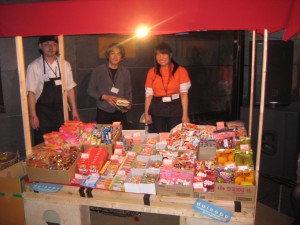
This weekend Japan Society hosted the inaugural 12-hour extravaganza known as “j-cation”. The line-up of events was kicked off by the movie Flavor of Happiness (幸せの香り or Shiawase no kaori), the story of a father-daughter relationship between an aging Chinese chef and his young female apprentice. A bit long and sappy, but the food images were to die for! In various corners of Japan Society several workshops were simultaneously taking place, such as Read More
WITLife is a periodic series written by professional Writer/Interpreter/Translator Stacy Smith (Kumamoto-ken CIR, 2000-03). She starts her day by watching Fujisankei’s newscast in Japanese, and here she shares some of the interesting tidbits and trends together with her own observations.
The other night I had the pleasure of meeting the author Jake Adelstein (pictured here on the Daily Show) who wrote the sensational book Tokyo Vice, the story of his time as a crime reporter in Japan. This absorbing memoir traces his path from Sophia University student to full-time reporter at the newspaper Yomiuri Shimbun, a notable feat for a foreigner. He spent 12 years covering the underbelly of Japan, and as expected the bulk of his talk concentrated on the yakuza.
He discussed how this Japanese mafia is known as a second police force, or a necessary evil (必要な悪 or hitsuyou na aku). As tracked by the police they number Read More
WIT Life #86: 日本の企業家精神
WITLife is a periodic series written by professional Writer/Interpreter/Translator Stacy Smith (Kumamoto-ken CIR, 2000-03). She starts her day by watching Fujisankei’s newscast in Japanese, and here she shares some of the interesting tidbits and trends together with her own observations.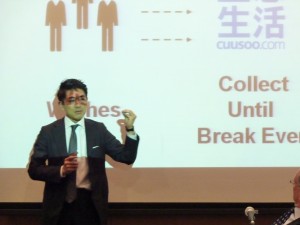
Last night I attended a symposium on Entrepreneurship in Japan (日本の企業家精神; nihon no kigyouka seishin) hosted by the Columbia Business School’s Center on Japanese Economy and Business. The three panelists (two present, one via video from Tokyo) represented a variety of generations and backgrounds. In 1985, American-born Ernest Matsuo Higa revolutionized Japanese home pizza delivery after obtaining the exclusive license to Domino’s Pizza. Atsushi Imuta (participating from Tokyo) quit his job at a Japanese bank to found RISA Partners, an invesment banking firm. Kohei Nishiyama, the youngest of the group who was raised in Columbia and went to university in Japan, invented the Design To Order system which allows manufacturers to reduce risk by carrying out product development based on customers’ requests.
An article on Japanese entrepreneurship in last month’s Eurobiz Japan highlights how within the Japan’s educational system there is the idea of Read More
WIT Life #85: New start
WITLife is a periodic series written by professional Writer/Interpreter/Translator Stacy Smith (Kumamoto-ken CIR, 2000-03). She starts her day by watching Fujisankei’s newscast in Japanese, and here she shares some of the interesting tidbits and trends together with her own observations.
Whereas here in the States today we celebrate April Fool’s Day, April 1st in Japan is a beginning. It is the start of the new fiscal and school years, and the blooming and subsequent falling of the cherry blossoms serves as a way to mark this transition. This morning’s news outlined several changes that will be taking place in accordance with the new year, but whether they will make life in Japan easier or harder remains to be seen.
- The child allowance law giving parents 13,000 yen per child per month goes into effect today, fulfilling one of the DPJ’s key campaign pledges. It differs from Read More
WIT Life #84: 国勢調査
**********************************************************************
WITLife is a periodic series written by professional Writer/Interpreter/Translator Stacy Smith (Kumamoto-ken CIR, 2000-03). She starts her day by watching Fujisankei’s newscast in Japanese, and here she shares some of the interesting tidbits and trends together with her own observations.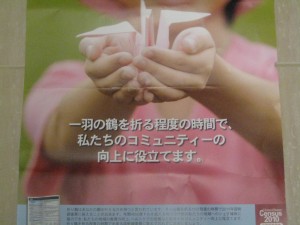
We are rapidly coming up on the deadline for the 国勢調査 (kokusei chousa) or national census, so I hope everyone has already filled in and returned their forms. Every morning during the Japanese news there are advertisements running in Japanese advocating participation in the census as one’s civic duty. Also, I have come across some interesting Japanese language print ads that I would like to share.
The one on the right shows Read More
WIT Life #82: 春分の日
WITLife is a periodic series written by professional Writer/Interpreter/Translator Stacy Smith (Kumamoto-ken CIR, 2000-03). She starts her day by watching Fujisankei’s newscast in Japanese, and here she shares some of the interesting tidbits and trends together with her own observations.![GetAttachment[3]](http://jetwit.com/wordpress/wp-content/uploads/2010/03/GetAttachment3-300x225.jpg)
Happy 春分の日 (shunbun no hi) or Spring Equinox Day! Like as with the autumnal equinox, on this occasion the day and the night should be of equal length. The mere mention of spring makes me feel like I should be seeing flowers popping their heads out of the ground. Unfortunately, here in Michigan where I’m translating at a local law firm there is no sign of greenery, although the snow flurries we had all day yesterday were quite a sight! I heard we’re getting much better weather back home in NYC, and![GetAttachment[2]](http://jetwit.com/wordpress/wp-content/uploads/2010/03/GetAttachment2-300x225.jpg) all I can say is I’m jealous…
all I can say is I’m jealous…
In Japan spring seems to have sprung, as I have gotten reports of the sakura beginning to bloom around the Imperial Palace. I also just received an email from my former co-worker at the Kumamoto International Center who was kind enough to send pictures of the sakura down south (you can see Kumamoto Castle in the background). Enjoy and happy spring!
WIT Life #81: Japanese high school tuition
WITLife is a periodic series written by professional Writer/Interpreter/Translator Stacy Smith (Kumamoto-ken CIR, 2000-03). She starts her day by watching Fujisankei’s newscast in Japanese, and here she shares some of the interesting tidbits and trends together with her own observations.
There is a bit of a controversy brewing over implementation of one aspect of the DPJ’s Manifesto. This is the proposal of free tuition for high schools currently being debated in the Diet. Students have to pay to attend high school as Japanese education is only compulsory through junior high. The question here is whether North Korean schools in Japan (of which there are 10 and where about 2,000 students of both North Korean and South Korean nationality are enrolled) should be similarly subsidized considering that Japan imposes economic sanctions on North Korea and in light of the yet unresolved abduction issue.
PM Hatoyama is waffling on this issue, with him initially Read More
WITLife is a periodic series written by professional Writer/Interpreter/Translator Stacy Smith (Kumamoto-ken CIR, 2000-03). She starts her day by watching Fujisankei’s newscast in Japanese, and here she shares some of the interesting tidbits and trends together with her own observations.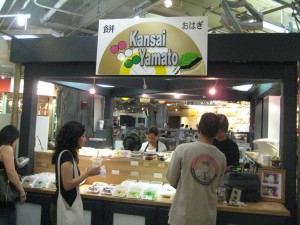
The group I was interpreting for this time returned to Japan yesterday, and I have been enjoying the last destination on our program: Hawaii! After a week of surf and sun I can’t say that I am particularly looking forward to leaving, but I suppose all good things must come to an end. One stop I knew I had to make while here was Kansai Yamato, a mochi maker located in the Ala Moana mall. It’s fun to watch them make and pack the mochi before your eyes at their small stall. Like the stores profiled in my recent writeup about wagashi in LA’s Little Tokyo, this establishment also has some pretty funky mochi flavors. When I went today, I counted 12 atypical varieties in addition to the standard ohagi, sakura mochi, kinako mochi, etc.
Some of the more un usual types were mango, honeydew and Hawaii gentei Kona coffee daifuku, but I wasn’t brave enough to try any of those. Instead I stuck with Read More
usual types were mango, honeydew and Hawaii gentei Kona coffee daifuku, but I wasn’t brave enough to try any of those. Instead I stuck with Read More
WIT Life #79: After the testimony
WITLife is a periodic series written by professional Writer/Interpreter/Translator Stacy Smith (Kumamoto-ken CIR, 2000-03). She starts her day by watching Fujisankei’s newscast in Japanese, and here she shares some of the interesting tidbits and trends together with her own observations.
A thought-provoking article in Salon regarding Japanese reactions at home to President Akio Toyoda’s Congressional testimony and apology to dealers. It describes how the populace was moved by him getting choked up when addressing the latter, but also that the Japanese can be fickle in their acclaim for someone. I found it interesting as I am currently traveling as an interpreter for a seven-person group of political aides, and they are overwhelming in their opinion that Japan is getting the short end of the stick regarding this situation.
At one dinner they expressed difficulty in understanding Read More
*************************
WITLife is a periodic series written by professional Writer/Interpreter/Translator Stacy Smith (Kumamoto-ken CIR, 2000-03). She starts her day by watching Fujisankei’s newscast in Japanese, and here she shares some of the interesting tidbits and trends together with her own observations.
I just started an assignment as an interpreter for a delegation of young political leaders from Japan, divided about evenly between members of the LDP and the DPJ as well as one journalist. Over our first dinner tonight it was interesting to hear their respective viewpoints regarding various issues, especially ones that are personal to them. For example, one DPJ rep and one LDP rep were having a friendly debate regarding day care. Both of these men have wives who work and 3-year old daughters, and as they live in the Tokyo area child care options are limited. There are not enough facilities to meet current needs, and those that exist are deluged by requests leading to long waiting lists.
As part of the Manifesto, the DPJ has proposed the implementation of a 子供手当て (kodomo teate) of 26,000 yen per month to provide financial aid to those who have a child. The LDP, on the other hand, does not advocate this and thinks this money should instead be put toward Read More
WIT Life #77: Breakdown of the bow
WITLife is a periodic series written by professional Writer/Interpreter/Translator Stacy Smith (Kumamoto-ken CIR, 2000-03). She starts her day by watching Fujisankei’s newscast in Japanese, and here she shares some of the interesting tidbits and trends together with her own observations.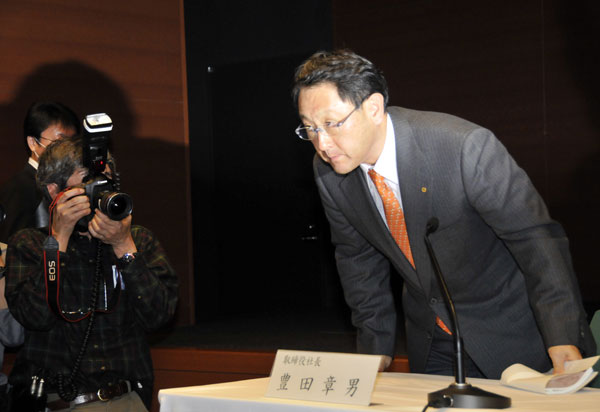
An interesting article this week in Slate analyzed the intricacies of the Japanese bow and its various gradations. It was in reference to the apology by Toyota President Akio Toyoda at a press conference last week regarding the company’s massive vehicle recall. His chosen bow was a keirei, or 30-degree tilt to show respect, though some say he should have opted for a saikeirei, or full 45- to 90-degree bow intended to show the greatest veneration or humility.
With the amount of damage control that Toyota needs at this point, perhaps it is true that Toyoda should have overshot with a deeper bow. However, critics were likely placated by yesterday’s news that Toyoda will testify before Congress regarding the recalls, something he had previously said he had no intention of doing. The threat of being subpoenaed by investigators seemed to have persuaded him to accept the formal invitation issued by the House Oversight and Government Reform Committee that followed an informal one. It remains to be seen how reassuring his testimony will be to the American public.
WIT Life #76: Mochi mochi appeal and V-Day marketing
WITLife is a periodic series written by professional Writer/Interpreter/Translator Stacy Smith (Kumamoto-ken CIR, 2000-03). She starts her day by watching Fujisankei’s newscast in Japanese, and here she shares some of the interesting tidbits and trends together with her own observations.
Recently the news ran a piece about the popularity of Japanese foods that are mocchiri, meaning heavy in a way similar to mochi. Evidently it is a Kansai-ben term that combines mochi mochi shita, sticky or springy, and dosshiri shita, heavy or solid. The top three reasons consumers cited for liking mocchiri goods were their texture, the ability to make them feel full and the attraction to items with mocchiri or mochi mochi in the name. In addition, they seem to provide a sense of comfort.
Many manufacturers are capitalizing on this mood by increasing their products that contain such descriptors. For example, a taiyaki maker with Read More
Adventures of a Stealth Gaijin: “E is for Elementary School” by Ann Chow
Adventures of a Stealth Gaijin
By Ann Chow (ALT, Hyogo-ken, 2007-2009), a New York City-based JET alum currently seeking copy editing/proofreading/production editing jobs in news or book publishing. Email jetwit [at] jetwit.com if you would like to get in touch with her.
E is for Elementary School
E is for elementary school.
 Elementary school in Japan is for students between the ages of 6-12, and they are easily spotted by the backpacks, called randoseru, that they carry. Sometimes, they wear sailor uniforms. Sometimes, they don’t. My students didn’t.
Elementary school in Japan is for students between the ages of 6-12, and they are easily spotted by the backpacks, called randoseru, that they carry. Sometimes, they wear sailor uniforms. Sometimes, they don’t. My students didn’t.
When I first arrived in Japan, the BoE I worked for told me I would be working at 2 junior high schools and 3 elementary schools. It was pretty standard for the ALTs working in my town, and I had no complaints except that one of my elementary schools was clear across town, 35 minutes or so by bike, and I wasn’t the ALT who lived closest to it.
Sometime in December of my first year there, I was told I would have to visit another elementary school. There was already another ALT who visited, but the teachers wanted extra lessons, so they added me on to the roster. On my first visit to that school, I was running late because I realized the main entrance to the school wasn’t on the main road, but on a back street behind the sports field and a construction site for new housing. It really didn’t help that they were Read More
****************************
WITLife is a periodic series written by professional Writer/Interpreter/Translator Stacy Smith (Kumamoto-ken, 2000-03). She starts her day by watching Fujisankei’s newscast in Japanese, and here she shares some of the interesting tidbits and trends together with her own observations.
In Japan measures are being taken to address the phenomenon of 畳離れ (tatami banare), or moving away from tatami. Many of us probably saw it when we lived over there, as friends’ houses were largely Western style except for the token 和室 (washitsu), or Japanese style-room. In order to make sure this integral part of the culture does not disappear, a certification has been created for eligible tatami craftsman which gives them the title of “doctor.”
One such craftsman in the prefecture of Tochigi, who estimates that over the last 29 years he has worked on  more than 120,000 mats, received his certification just last year. He is now called a 「畳ドクター」 (tatami doctor), a designation that he admits he is not quite used to. However, like an MD he Read More
more than 120,000 mats, received his certification just last year. He is now called a 「畳ドクター」 (tatami doctor), a designation that he admits he is not quite used to. However, like an MD he Read More
WIT Life #74: Japan Society Food Forum
WITLife is a periodic series written by professional Writer/Interpreter/Translator Stacy Smith (Kumamoto-ken, 2000-03). She starts her day by watching Fujisankei’s newscast in Japanese, and here she shares some of the interesting tidbits and trends together with her own observations.
Last night I went to an event at Japan Society entitled “Wasabi on a Hot Dog?” which discussed the incorporation of Japanese ingredients and cooking styles into non-Japanese food. The speakers were Michael Anthony, executive chef of Gramercy Tavern, and Craig Koketsu, Executive Chef at Park Avenue Autumn/Winter, and the discussion was moderated by NYT Dining section reporter Julia Moskin. They both spoke of the importance of seasonality as a Japanese concept that they have introduced, which is said to be revolutionary but really is at the root of all cooking. It was interesting to hear about Anthony’s time training with a female chef at a French bistro in Tokyo, and of Koketsu growing up in California as a third-generation Japanese-American and how this has affected his work.
However, by far the greatest contribution of the evening was the off the cuff remarks Read More

